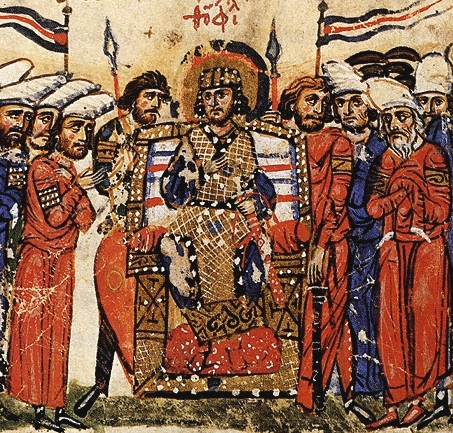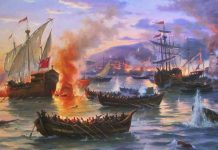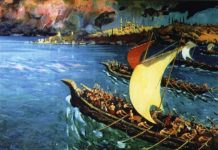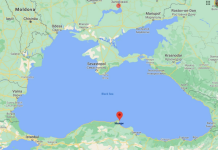Old Testament, Book of Ezekiel, 38, 1-3. “And the word of the Lord came unto me, saying, Son of man, set thy face toward Gog, of the land of Magog, the prince of Rosh, Meshech, and Tubal… And thou (Gog) shalt come from thy place out of the uttermost parts of the north, thou and many peoples with thee, all of them riding upon horses, a great company and a mighty army…Surely in that day, there shall be a great shaking in the land of Israel; so that the fishes of the sea, and the fowls of the heaven, and the beasts of the field, and all creeping things that creep upon the earth, shall shake at my presence, and the mountains shall be thrown down, and the steep places shall fall, and every wall shall fall to the ground. (New King James Version Bible). As can be seen, in the Old Testament, Gog is an individual and Magog is his land; Rosh, Meshech, and Tubai appear to be three nations/tribes over whom Gog was a prince. In the New Testament’s Book of Revelation 20:8, “Gog from Magog” became “Gog and Magog”. Various nations and places were offered as possible candidates for Gog and Magog. Josephus Flavius (37-100 AD) provides the earliest known explanation and interpretation of Gog and Magog. It is important to read about the authority of Josephus on the subject: “Carl Ritter, in his highly influential Erdkunde in the 1840s, wrote in a review of authorities on the ancient geography of the region:
Outside of the Scriptures, Josephus holds the first and the only place among the native authors of Judaea; for Philo of Alexandria, the later Talmud, and other authorities, are of little service in understanding the geography of the country. Josephus is, however, to be used with great care. As a Jewish scholar, as an officer of Galilee, as a military man, and a person of great experience in everything belonging to his own nation, he attained to that remarkable familiarity with his country in every part, which his antiquarian researches so abundantly evince…” – says the Wikipedia article linked above. Josephus identified the sons of Magog with the Scythians: “Magog founded those that from him were named Magogites, but who are by the Greeks called Scythians”. Dr. Andrew Runny Anderson in his 1932 monograph stated: “As the geographical horizon widened, Magog was placed north of the Caucasus. Such is the logical extension that must be given to the interpretation of the phrases, ‘Gog of the land of Magog’ … out of the uttermost part of the north,’ as described by Ezekiel. Indeed, the logic of the expression required that his location should ultimately be placed adjoining the northern ocean, as indeed is done in both the Hereford and the Ebstorf maps. Ezekiel’s description of the invasion of Gog may be an echo of the invasion of the Cimmerians, who came down from the north by way of the pass of Dariel towards the end of the eighth century B. C. in the reign of Sargon of Assyria (722-705 B. C.), or more probably of the incursion of the Scythians, who descended by way of the pass of Derbend in the following century under Esar-Haddon, 681-668 B. So devastating were these inroads that they gave the impression that the end of the world was at hand. The term ‘Gog and Magog‘ has therefore become synonymous with barbarian, especially with the type of barbarian that bursts through the northern frontier of civilization”. Although in Judaic, Christian, and even Islamic traditions ‘Gog and Magog’ became the symbols of evil powers, it appears to be a misinterpretation and misunderstanding of the initial meaning because in the prophecy of Ezekiel, Gog and his people are the eschatological symbols of Divine Wrath. For some reason, scholars and theologists missed an interesting passage in the Bible that has a curious combination of the crucial components – people from the north, horses, – that were part of Ezekiel’s prophecy about Gog from Magog:
Behold, a people comes from the north country,
And a great nation will be raised from the farthest parts of the earth.
They will lay hold on bow and spear;
They are cruel and have no mercy;
Their voice roars like the sea;
And they ride on horses,
As men of war set in array against you, O daughter of Zion.
We have heard the report of it;
Our hands grow feeble.
Anguish has taken hold of us,
Pain as of a woman in labor. (Jeremiah 6:23-24)
Prominent French historian and orientalist, Constantin Volney (whose works Thomas Jefferson translated into English), was confident that “chapters 1, 4, 5, and 6 of the Book of Jeremiah referred to the Scythian invasion… with the exception of certain interpolations in chapters, 1 and 3, the whole of the first six chapters date from this period.”
How do the events of the 7th century BC relate to Kyiv of the 10th century AD?
Byzantine court historian Leo the Deacon who eyewitnessed the epic battles between the forces of Sviatoslav the Brave of Kyiv and the Byzantine Empire in 971 AD, wrote the following about the Rus:
“That this people is reckless and warlike and mighty, and attacks all the neighboring peoples, is attested by many people, among them the holy Ezekiel, who alludes to them when he says as follows: “Behold, I will bring upon you Gog and Magog, the ruler of the Rosy”.
For such a prominent historian as Leo the Deacon, there was no doubt that Sviatoslav and his people were the same nation as the ancient Gog of the Biblical times. He also recognized that the name of the nation Rosy derived from the name Rosh whose prince Gog was.
The title image for this article is also used in ‘Gog and Magog‘ Wikipedia one and has the following comment to it: ‘A Byzantine ruler protected by two Vikings, often compared with Gog and Magog (John Skylitzes – Madrid Skylitzes, folio 42 (p. 94). And another correction needs to be made in this regard: “The Rus provided the earliest members of the Varangian Guard. They were in Byzantine service from as early as 874,” says the corresponding Wiki article. The Rus were compared with Gog and Magog. Yes, at that time Kyiv controlled Constantinople. (Since it is Byzantine Emperor Theophilos portrayed by Skylitzes whose rule was betweetn 829–842, Kyiv must have provided security services to Byzantium rulers much earlier than 874).
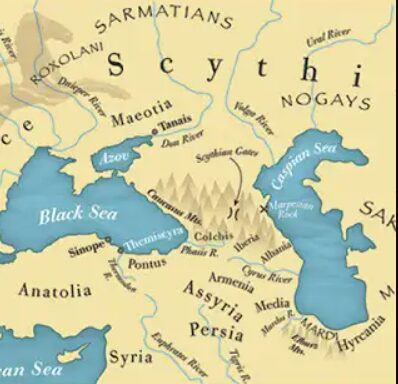
Dr. Andrew Runny Anderson whose article ‘Alexander’s Gate, Gog and Magog, and the Inclosed Nations‘ (Cambridge, Mass., 1932) was quoted earlier, wrote also the following: “From the time of the Armenian expedition of Corbulo (57-67 AD) under the emperor Nero down to the middle of the sixth century, certain authors— Tacitus, Suetonius, Josephus, Hegesippus, St Jerome, Procopius, and Jordanes— apply the term Caspian Gates to the pass of Dariel in the central Caucasus, and either expressly state or imply that Alexander built a gate there”. Those historians believed that Alexander the Great built the iron gates to protect the civilized world from the barbarians such as Gog and Magog. Although Dr. Anderson concluded that Alexander never saw the Caucasus in his lifetime, the idea that the Scythians were barbarians lives to our days. In this aspect, the readers may want to find out what the Scythians told Alexander the Great regarding true barbarism. The “Royal Scythia, Greece, Kyiv Rus” book has that conversation and many other little-known facts of the Scythian history and origin.



